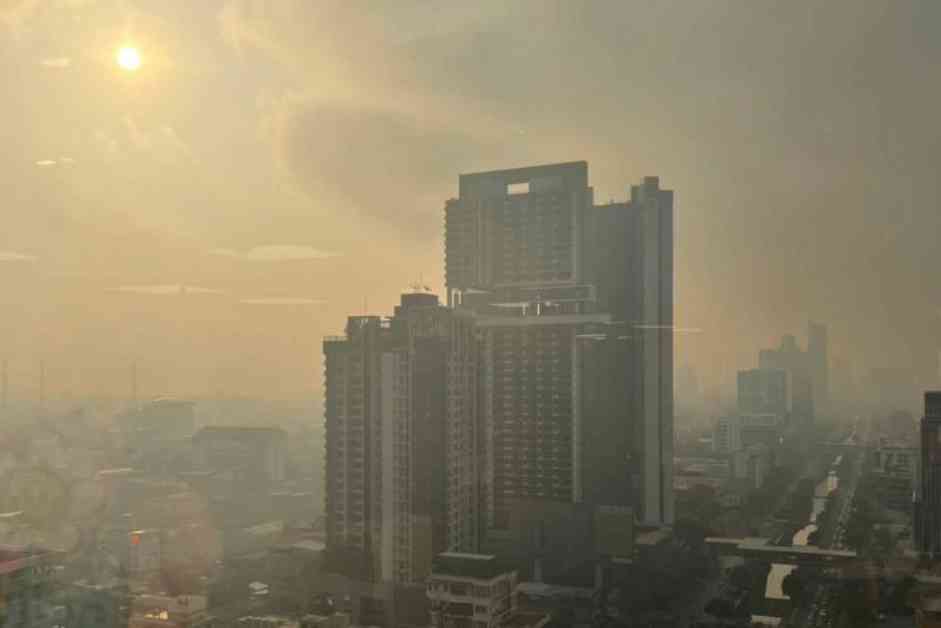The smoggy morning in Bangkok on Monday served as a stark reminder of the hazardous air pollution plaguing Thailand. According to the Geo-Informatics and Space Technology Development Agency (Gistda), a staggering 57 out of 77 provinces in the country were shrouded in unsafe levels of ultrafine dust pollution. This concerning report, released at 8 am, highlighted the severity of the situation, with 13 provinces facing red levels of particulate matter 2.5 micrometres and less in diameter (PM2.5).
Nong Bua Lam Phu emerged as the hardest-hit province, with a red level of PM2.5 measuring at a worrying 99.1 microgrammes per cubic meter of air over the past 24 hours. Following closely behind were Si Sa Ket, Ubon Ratchathani, Kalasin, Surin, Buri Ram, Maha Sarakham, Sing Buri, Khon Kaen, Roi Et, Udon Thani, Bangkok, and Saraburi, all grappling with dangerously high levels of PM2.5. The government-declared safe threshold stands at 37.5 microgrammes per cubic meter.
In stark contrast, 20 provinces in the North and the South boasted safe air quality, providing a respite from the pervasive pollution. On the other hand, 16 provinces experienced moderate air quality, characterized by yellow levels of PM2.5, ranging from 27 to 36.5 microgrammes per cubic meter. These provinces included Pattani, Yala, Satun, Phatthalung, Narathiwat, Phuket, Songkhla, Trang, Lampang, Phayao, Phangnga, Ranong, Surat Thani, Chiang Rai, Chumphon, and Nakhon Si Thammarat.
Meanwhile, Krabi, Lamphun, Chiang Mai, and Mae Hong Son enjoyed good air quality, offering a glimpse of fresh, clean air amidst the pollution crisis. However, the situation remained dire in 44 other provinces, where orange levels of PM2.5, indicating a start to health impacts, were recorded. Provinces such as Ayutthaya, Kanchanaburi, Nakhon Ratchasima, Prachuap Khiri Khan, Rayong, and Samut Prakan grappled with PM2.5 levels ranging from 44.1 to 74.8 microgrammes per cubic meter.
As the map from Gistda vividly illustrates, the varying degrees of air quality across different regions paint a concerning picture of the air pollution crisis in Thailand. The stark disparities between provinces facing hazardous pollution levels and those enjoying clean air underscore the urgent need for comprehensive measures to address this critical issue. The health and well-being of citizens are at stake, demanding immediate action to mitigate the harmful effects of air pollution and safeguard public health.
Expert Insights and Recommendations
In the face of escalating air pollution levels across multiple provinces in Thailand, experts have emphasized the critical importance of proactive measures to combat this pressing issue. Dr. Somchai Bovornkitti, a renowned environmental scientist, underscored the detrimental impact of PM2.5 on public health, urging authorities to prioritize air quality management strategies.
According to Dr. Bovornkitti, “The alarming levels of PM2.5 in numerous provinces pose a significant threat to respiratory health and overall well-being. It is imperative for government agencies to implement stringent air pollution control measures, including emission reduction policies and public awareness campaigns, to mitigate the adverse effects of air pollution on the population.”
Furthermore, environmental organizations have called for collaborative efforts between governmental bodies, civil society organizations, and the general public to address the root causes of air pollution and promote sustainable practices that prioritize clean air quality. Through collective action and informed decision-making, Thailand can work towards a cleaner, healthier environment for all its citizens.
Community Resilience and Advocacy
Amidst the challenges posed by widespread air pollution, communities across Thailand have demonstrated remarkable resilience and advocacy in raising awareness about the importance of clean air and environmental conservation. Local initiatives focusing on air quality monitoring, tree planting campaigns, and eco-friendly practices have gained momentum, empowering individuals to take proactive steps towards mitigating pollution levels in their surroundings.
One such community-driven initiative in Chiang Mai, known as “Green Lungs for Clean Air,” has mobilized residents to plant trees and create green spaces to combat air pollution and enhance the city’s air quality. Through grassroots efforts and community engagement, these initiatives serve as powerful examples of citizen-led action to address environmental challenges and foster sustainable development.
As Thailand grapples with the pervasive threat of air pollution, the resilience and advocacy of local communities offer a beacon of hope for a cleaner, greener future. By uniting efforts at the grassroots level and advocating for policy changes at the national level, citizens can drive positive change and safeguard the environment for generations to come.




















